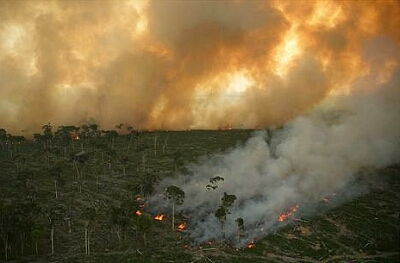
Countdown to Earth Day
April 19, 2004

Part of the Amazonian rainforest being burned by the American company, Cargill, for planting soy.
Photo credit: Greenpeace
The following is from the Rainforest Alliance at: http://www.rainforest-alliance.org/resources/forest-facts.html
Tropical Forest Facts
--Forests: Then & Now--
• 8,000 years ago, the Earth was covered by approximately 14.8 billion acres of forests. 1
• The world's forest area has now shrunk to 8.6 billion acres as a consequence of human exploitation -- most of which occurred in the last 50 years. 2
• In 1800, there were 7.1 billion acres of tropical forest worldwide. 1
• There are 3.5 billion acres of tropical forest remaining. 3
--Our Shrinking Tropical Forests--
• We're losing 33.8 million acres of tropical forest per year – More than the total area of New Hampshire, Vermont, Massachusetts, Rhode Island, Connecticut, New Jersey and Delaware combined – 2.8 million acres lost per month...93,000 acres/day...3,800 acres/hour...64 acres/minute. 3
• Between 1960-1990, 1.1 billion acres of tropical forest were cleared. 4
• Brazil lost 91.4 million acres of tropical forest between 1980-1990 – Almost the total area of North and South Dakota combined. 4
• Asia lost almost a third of its tropical forest cover between 1960-1980 --the highest rate of forest conversion in the world. 4
• Almost 90% of West Africa's rainforest has already been destroyed. 4
• 75% of Australia's tropical rainforest has been cleared since the late 1700's. 5
--Species Extinction--
• We lose 100 species every day -- 4 species per hour --due to tropical deforestation. 5
• At current rates, 5-10% of tropical forest species will become extinct every decade. 5
• About 50% of all mammals and 25% of all bird species in peninsular Malaysia will become extinct by the year 2020. 6
--Species & Their Tropical Homes--
• Over 50% of the Earth's species live in tropical forests. 3
• Tropical forests contain 70% of the world's vascular plants, 30% of all bird species and 90% of all invertebrates. 1
• 90% of all primates are found only in tropical forest regions of Latin America, Africa and Asia. 7
• In Brazil's Atlantic Rainforest, 70% of its plants and most of its 20 primate species are endemic (found nowhere else in the world) – 95% of this rainforest has been destroyed. 4
• 43 ant species were found on one tree in Peru --the same number as in the entire British Isles. 8
• Ecuador's tropical forests contain over 15,000 plant species. There are 13,000 plant species in all of Europe. 9
• Madagascar is 2% of Africa's land mass but has 10,000 species of plants – 80% are endemic. 10 Madagascar is home to all of the world's lemurs (primate species) – all are endangered. 7 Almost 90% of Madagascar's forests have been destroyed. 3
• 780 tree species have been found in a 25 acre plot of Malaysian rainforest-- 9 more than the total number of tree species native to the US and Canada. 11
--Medicinal Plants--
• Medicines that derive from tropical forest plants include: Curare (muscle relaxant used in surgery), Diosgenin (birth control pills, arthritis, asthma), Ouabain (heart medication), Quinine (malaria, pneumonia), Emetine (bronchitis, dysentery), Vincristine/Vinblastine (Hodgkin's disease, leukemia, other cancers). 9
• Over 2,000 tropical plants have been identified by scientists as having anti-cancer properties. 12
• In Southeast Asia, traditional healers use 6,500 plants in treatments for malaria, stomach ulcers, syphilis and assorted other disorders. 9
• Indigenous peoples of Northwest Amazonia use over 1,300 plant species as medicines. 13
--Indigenous Peoples--
• Before 1500, there were approximately 6 million indigenous people living in Brazilian Amazonia. In the early 1990's, there were less than 250,000. 14
• Over 90 different Amazonian tribes are thought to have disappeared this century. 14
___________________________________________________________________
These facts come from the following sources (April 1999):
1 Deforestation: Tropical Forests in Decline, Canadian International Development Agency, www.rcfa-cfan.org/English/issues.12.html, 1998.
2 State of the World's Forests 1997, Food & Agriculture Organization of the United Nations.
3 1998-99 World Resources: A Guide to the Global Environment, A Joint Publication of the World Resources Institute, U.N. Environment Programme, U.N. Development Programme and the World Bank, Oxford University Press, 1998.
4 The Last Frontier Forests, World Resources Institute (WRI), 1997.
5 "Tropical Forests," WRI, www.wri.org/biodiv/tropical.html, 1998.
6 Danish Coop. for Environment & Development -- with data from World Conservation Union & Malaysian Nature Society, 1998.
7 The Pictorial Guide to the Living Primates, Noel Rowe, Pogonias Press, 1996.
8 The Diversity of Life, E.O. Wilson, Belknap Press, Harvard University, 1992.
9 The Primary Source, Norman Myers, WW Norton, 1992.
10 The Conservation Atlas of Tropical Forests: Africa, The World Conservation Union, Simon & Schuster, 1992.
11 There are 679 tree species native to the U.S. & Canada, according to: A Field Guide to the Major Native and Introduced Species North of Mexico: Trees of North America, C. Frank Brockman, Golden Press, 1986.
12 Trees of Life: Saving Tropical Forests and their Biological Wealth, Kenton Miller & Laura Tangley, WRI/Beacon Press, 1991.
13 The Healing Forest, R.E. Schultes & R.F. Raffauf, Dioscorides Press, 1990.
14 Cultural Survival, 617-441-5400. Also, see footnote 12, Trees of Life.
Some simple actions you can take to help save our vanishing rainforests:
The next time you buy a wood product (e.g., furniture), ask if the wood is certified through the Smartwood® program. Smartwood® certification means that the wood is produced in accordance with sustainable and environmentally sound management practices. Find out more at: http://www.smartwood.org/index.html.
Next time you buy coffee, buy one labeled “Shade grown” or “Fair Trade.” These labels indicate that the coffee was grown using sustainable practices which limit impacts to rain forests. They also return more of the value of the crop to the individual farmer. And taste? Shade grown coffee is preferred by coffee experts. Many distributors provide fair trade and shade grown varieties (Starbucks, Caribou Coffee, Seattle’s Best). Learn more about other Free Trade products at: http://www.fairtradefederation.com/